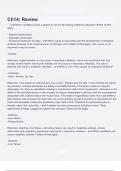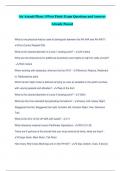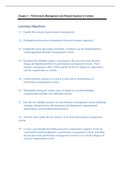STUVIA 2024/2025
Ch14; Review
- - ✔✔Which conditions place a patient at risk for developing metabolic alkalosis? Select all that
apply.
- Diabetic ketoacidosis
- Salicylate intoxication
- Excessive fasting for 30 days - ✔✔Which cause is associated with the development of metabolic
acidosis because of an overproduction of hydrogen ions? Select all that apply. One, some, or all
responses may be correct.
-Anxiety
Rationale: Hyperventilation is one cause of respiratory alkalosis, which can result from fear and
anxiety. Kidney failure and diuretic therapy are not causes of respiratory alkalosis. The use of
antacids can result in metabolic alkalosis. - ✔✔What is one of the causes of respiratory alkalosis?
-Confusion
-Warm, flushed, dry skin
%
Rationale: If the patient is confused and has a warm, flushed, and dry skin, it may indicate the patient
has acidosis. Acidosis decreases the ability of excitable tissues in the blood vessels to respond
adequately. So, there is vasodilation leading to hypotension rather than hypertension. Decrease in the
ability of the excitable tissues in the muscles to respond adequately to stimulus and the hyperkalemia
associated with acidosis reduce the muscle tone. This leads to hyporeflexia rather than hyperreflexia.
Mild acidosis may increase the heart rate, but as the acidosis worsens and there is hyperkalemia, the
heart rate decreases making the peripheral pulse hard to find. Therefore the peripheral pulse is
thready rather than pounding. - ✔✔A patient has been poisoned by botulinum toxins. What
assessment findings suggest the patient has acidosis? Select all that apply.
-Diarrhea
-Liver failure
-Kidney failure
Rationale: Diarrhea, liver failure, and kidney failure can result in metabolic acidosis. Airway
obstruction and respiratory depression may result in respiratory acidosis. - ✔✔Which conditions can
cause metabolic acidosis? Select all that apply.
-Diarrhea
-Liver failure
stuvia
, STUVIA 2024/2025
-Kidney failure - ✔✔Which condition can cause metabolic acidosis? Select all that apply. One, some,
or all responses may be correct.
-Kidney failure
Rationale: Causes of acidosis include kidney failure, pancreatitis, liver failure, and dehydration.
Excessive body fluids, heart failure, and colitis are causes of alkalosis. - ✔✔What is one of the
causes of acidosis?
-Lungs and kidneys
Rationale: Blood pH represents a delicate balance between hydrogen ions (acid) and bicarbonate
anions (base), which is largely controlled by the lungs and kidneys. The lungs adjust the blood pH by
releasing or retaining hydrogen ions (acid), and the kidneys adjust the blood pH by releasing or
retaining bicarbonate anions (base). The liver plays a role in metabolism, immunity, and clotting. The
pancreas releases insulin for glucose metabolism and enzymes for digestion. The brain plays a
secondary role in maintaining pH balance by sensing the need for alterations in acid or base levels
and sends appropriate signals to the kidneys and lungs. - ✔✔Which organs play major roles in
maintaining pH balance in the body?
%
-Maintaining blood glucose level within normal limits.
Rationale: Maintaining blood glucose levels within normal limits is the best way to decrease the risk of
acid-base imbalance. Blood glucose levels must be checked not once but several times a day.
Drinking 3 L of fluid per day is not necessary to maintain acid-base balance. Eating regularly is a way
to achieve acid-base balance but is not the goal itself. - ✔✔To decrease the risk of acid-base
imbalance, what goal must the patient with diabetes mellitus strive for?
-Normal pH on arterial blood gases
Rationale: Arterial blood gas pH returns to normal when the body's compensatory efforts are fully
effective. Glucose, potassium, and bicarbonate are affected by diabetic acidosis, but their return to
normal is not an indicator of acid-base balance. - ✔✔When evaluating the laboratory results of a
patient with diabetic ketoacidosis, which lab value indicates the body has fully compensated from this
acid-base imbalance?
-Numbness around the mouth
-Hyperactivity of deep tendon reflexes - ✔✔Which clinical manifestation would the nurse likely
assess in a patient with metabolic alkalosis?
stuvia
, STUVIA 2024/2025
-Overproduction of hydrogen ions
Rationale: In diabetic ketoacidosis, there is an excessive breakdown of fatty acids. This produces
strong acids (ketoacids) with the release of large amounts of hydrogen ions. Underelimination of
hydrogen ions occurs when hydrogen ions are produced at normal rates, but their elimination is
reduced. This is seen in patients with lung and kidney problems. Bicarbonate ion is made in the
kidney or in the pancreas. In patients with impaired kidney or pancreatic function, there is
underproduction of bicarbonate ions leading to acidosis. Overelimination of bicarbonate ions occurs
when there is an excessive loss of bicarbonate ions. This occurs in diarrhea. - ✔✔A diabetic patient
shows symptoms of diabetic ketoacidosis. What mechanism causes acidosis in this patient?
-pH 7.49, HCO 3 - 32
Rationale: In metabolic alkalosis, pH is greater than 7.45 and HCO 3 - is greater than 28. pH 7.28 and
CO 2 54 = respiratory acidosis (pH < 7.35, CO 2 >45). pH 7.53 and CO 2 28 = respiratory alkalosis
(pH > 7.45, CO 2 < 35). pH 7.31 and HCO 3 - 18 = metabolic acidosis (pH < 7.35, HCO 3 - < 21). -
✔✔Which arterial blood gas laboratory values would be seen in metabolic alkalosis?
-Reported heavy alcohol consumption
-Chronic cirrhosis of the liver with liver failure
%
-Seizure in the ambulance on the way to the hospital - ✔✔Which factor contributes to the
development of metabolic acidosis? Select all that apply. One, some, or all responses may be correct
-Respiratory Acidosis
Rationale: In respiratory acidosis, there is a decrease in pH (normal is 7.35-7.45), a normal
bicarbonate (normal is 21-28), a decreased PaO 2 (normal is 80-100), and an increased PaCO 2
(normal is 35-45). The arterial blood gas results of pH 7.32; bicarbonate 24; PaO 2 77; PaCO 2 48
reflect respiratory acidosis. In respiratory alkalosis, there is an increase in pH, a normal bicarbonate,
a normal PaO 2, and a decrease in PaCO 2. In metabolic alkalosis, there is an increase in pH,
increase bicarbonate, normal PaO 2, and normal PaCO 2. In metabolic acidosis, there is a decrease
in pH, decrease bicarbonate, normal PaO 2, and normal PaCO 2. - ✔✔A lab report for a 47-year-old
patient shows the following results: pH 7.32; bicarbonate 24; PaO 2 77; PaCO 2 48. These findings
are consistent with which acid-base imbalance?
-Respiratory acidosis
Rationale: Respiratory acidosis is related to CO 2 retention secondary to respiratory depression,
inadequate chest expansion, airway obstruction, or reduced alveolar-capillary diffusion. Respiratory
acidosis is common in morbidly obese patients who experience inadequate chest expansion owing to
stuvia
Ch14; Review
- - ✔✔Which conditions place a patient at risk for developing metabolic alkalosis? Select all that
apply.
- Diabetic ketoacidosis
- Salicylate intoxication
- Excessive fasting for 30 days - ✔✔Which cause is associated with the development of metabolic
acidosis because of an overproduction of hydrogen ions? Select all that apply. One, some, or all
responses may be correct.
-Anxiety
Rationale: Hyperventilation is one cause of respiratory alkalosis, which can result from fear and
anxiety. Kidney failure and diuretic therapy are not causes of respiratory alkalosis. The use of
antacids can result in metabolic alkalosis. - ✔✔What is one of the causes of respiratory alkalosis?
-Confusion
-Warm, flushed, dry skin
%
Rationale: If the patient is confused and has a warm, flushed, and dry skin, it may indicate the patient
has acidosis. Acidosis decreases the ability of excitable tissues in the blood vessels to respond
adequately. So, there is vasodilation leading to hypotension rather than hypertension. Decrease in the
ability of the excitable tissues in the muscles to respond adequately to stimulus and the hyperkalemia
associated with acidosis reduce the muscle tone. This leads to hyporeflexia rather than hyperreflexia.
Mild acidosis may increase the heart rate, but as the acidosis worsens and there is hyperkalemia, the
heart rate decreases making the peripheral pulse hard to find. Therefore the peripheral pulse is
thready rather than pounding. - ✔✔A patient has been poisoned by botulinum toxins. What
assessment findings suggest the patient has acidosis? Select all that apply.
-Diarrhea
-Liver failure
-Kidney failure
Rationale: Diarrhea, liver failure, and kidney failure can result in metabolic acidosis. Airway
obstruction and respiratory depression may result in respiratory acidosis. - ✔✔Which conditions can
cause metabolic acidosis? Select all that apply.
-Diarrhea
-Liver failure
stuvia
, STUVIA 2024/2025
-Kidney failure - ✔✔Which condition can cause metabolic acidosis? Select all that apply. One, some,
or all responses may be correct.
-Kidney failure
Rationale: Causes of acidosis include kidney failure, pancreatitis, liver failure, and dehydration.
Excessive body fluids, heart failure, and colitis are causes of alkalosis. - ✔✔What is one of the
causes of acidosis?
-Lungs and kidneys
Rationale: Blood pH represents a delicate balance between hydrogen ions (acid) and bicarbonate
anions (base), which is largely controlled by the lungs and kidneys. The lungs adjust the blood pH by
releasing or retaining hydrogen ions (acid), and the kidneys adjust the blood pH by releasing or
retaining bicarbonate anions (base). The liver plays a role in metabolism, immunity, and clotting. The
pancreas releases insulin for glucose metabolism and enzymes for digestion. The brain plays a
secondary role in maintaining pH balance by sensing the need for alterations in acid or base levels
and sends appropriate signals to the kidneys and lungs. - ✔✔Which organs play major roles in
maintaining pH balance in the body?
%
-Maintaining blood glucose level within normal limits.
Rationale: Maintaining blood glucose levels within normal limits is the best way to decrease the risk of
acid-base imbalance. Blood glucose levels must be checked not once but several times a day.
Drinking 3 L of fluid per day is not necessary to maintain acid-base balance. Eating regularly is a way
to achieve acid-base balance but is not the goal itself. - ✔✔To decrease the risk of acid-base
imbalance, what goal must the patient with diabetes mellitus strive for?
-Normal pH on arterial blood gases
Rationale: Arterial blood gas pH returns to normal when the body's compensatory efforts are fully
effective. Glucose, potassium, and bicarbonate are affected by diabetic acidosis, but their return to
normal is not an indicator of acid-base balance. - ✔✔When evaluating the laboratory results of a
patient with diabetic ketoacidosis, which lab value indicates the body has fully compensated from this
acid-base imbalance?
-Numbness around the mouth
-Hyperactivity of deep tendon reflexes - ✔✔Which clinical manifestation would the nurse likely
assess in a patient with metabolic alkalosis?
stuvia
, STUVIA 2024/2025
-Overproduction of hydrogen ions
Rationale: In diabetic ketoacidosis, there is an excessive breakdown of fatty acids. This produces
strong acids (ketoacids) with the release of large amounts of hydrogen ions. Underelimination of
hydrogen ions occurs when hydrogen ions are produced at normal rates, but their elimination is
reduced. This is seen in patients with lung and kidney problems. Bicarbonate ion is made in the
kidney or in the pancreas. In patients with impaired kidney or pancreatic function, there is
underproduction of bicarbonate ions leading to acidosis. Overelimination of bicarbonate ions occurs
when there is an excessive loss of bicarbonate ions. This occurs in diarrhea. - ✔✔A diabetic patient
shows symptoms of diabetic ketoacidosis. What mechanism causes acidosis in this patient?
-pH 7.49, HCO 3 - 32
Rationale: In metabolic alkalosis, pH is greater than 7.45 and HCO 3 - is greater than 28. pH 7.28 and
CO 2 54 = respiratory acidosis (pH < 7.35, CO 2 >45). pH 7.53 and CO 2 28 = respiratory alkalosis
(pH > 7.45, CO 2 < 35). pH 7.31 and HCO 3 - 18 = metabolic acidosis (pH < 7.35, HCO 3 - < 21). -
✔✔Which arterial blood gas laboratory values would be seen in metabolic alkalosis?
-Reported heavy alcohol consumption
-Chronic cirrhosis of the liver with liver failure
%
-Seizure in the ambulance on the way to the hospital - ✔✔Which factor contributes to the
development of metabolic acidosis? Select all that apply. One, some, or all responses may be correct
-Respiratory Acidosis
Rationale: In respiratory acidosis, there is a decrease in pH (normal is 7.35-7.45), a normal
bicarbonate (normal is 21-28), a decreased PaO 2 (normal is 80-100), and an increased PaCO 2
(normal is 35-45). The arterial blood gas results of pH 7.32; bicarbonate 24; PaO 2 77; PaCO 2 48
reflect respiratory acidosis. In respiratory alkalosis, there is an increase in pH, a normal bicarbonate,
a normal PaO 2, and a decrease in PaCO 2. In metabolic alkalosis, there is an increase in pH,
increase bicarbonate, normal PaO 2, and normal PaCO 2. In metabolic acidosis, there is a decrease
in pH, decrease bicarbonate, normal PaO 2, and normal PaCO 2. - ✔✔A lab report for a 47-year-old
patient shows the following results: pH 7.32; bicarbonate 24; PaO 2 77; PaCO 2 48. These findings
are consistent with which acid-base imbalance?
-Respiratory acidosis
Rationale: Respiratory acidosis is related to CO 2 retention secondary to respiratory depression,
inadequate chest expansion, airway obstruction, or reduced alveolar-capillary diffusion. Respiratory
acidosis is common in morbidly obese patients who experience inadequate chest expansion owing to
stuvia




